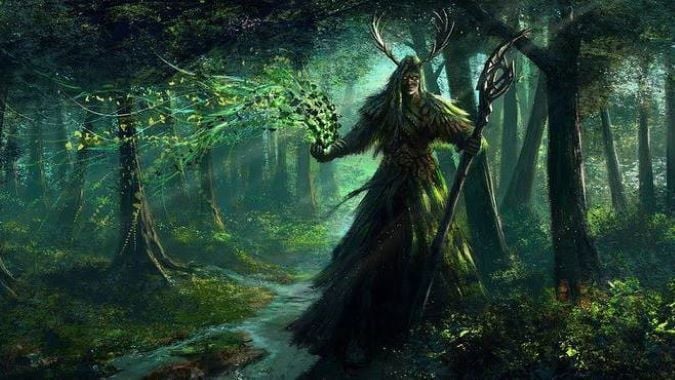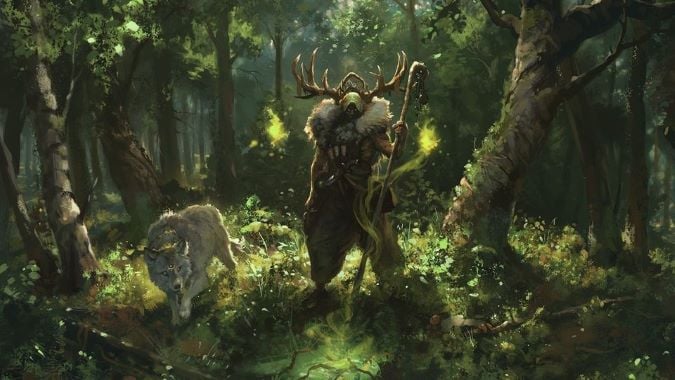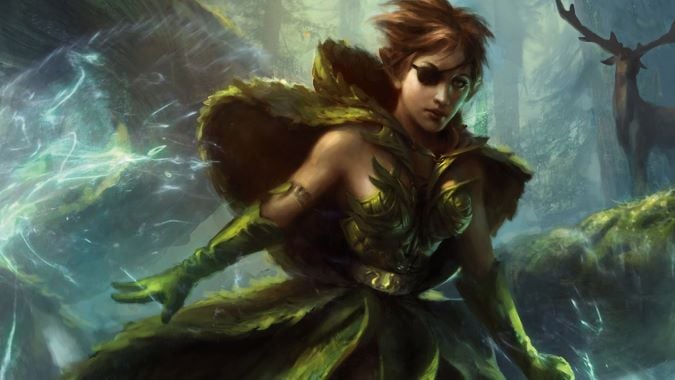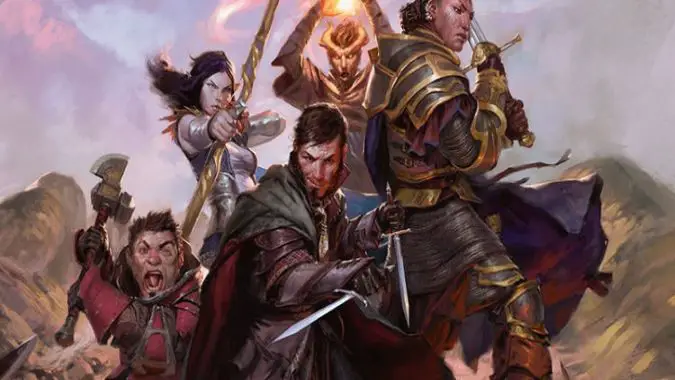D&D Classes 101: Getting started with the Druid

When creating your character in Dungeons and Dragons, the first two major choices are choosing your race, and choosing your class. Now that you’ve chosen Druid, what does that mean? Let’s take a high-level look at what a Druid is in D&D, and the subclass options.
A Druid focuses on Nature. In D&D, nature includes beasts, plants, environments, the elements, spirits, the undead, and the stars — in other words, almost anything. This gives Druids a diverse range of spells to choose from, and a wide range of roles to fill. Druids can fill in as damage dealers in melee or ranged positions. They can be tanks. They heal the group. They can buff other players. They can summon additional creatures to aid in battle. This class is very much a jack-of-all-trades, and can specialize to become a master in at least one.
At level 2, every Druid gains the ability Wild Shape. This allows the Druid to use an Action to shape shift into a beast, and this ability grows more powerful as the Druid levels up. At level 4 this animal may be aquatic with a swim speed, and at level 8 this beast may allow the Druid to fly.
Also at level 2, a Druid chooses a subclass, called a Circle. This is a big decision which completely changes how the Druid plays going forward, so we’ll discuss each Circle separately in terms of your later-game options. There are currently five Circles available, with one more in beta testing. We’ll break down these subclasses by the book that introduced them.
The Player’s Handbook
The Player’s Handbook offers two subclasses. When creating a character on DnDBeyond.com, these are free to create. For base subclasses, these are good options to start with.
Circle of the Moon
This subclass focuses on Wild Shape, which allows a Druid to change into a beast. The Circle of the Moon Druid can shape shift as a Bonus Action, rather than an Action, allowing the character to attack on the very turn it shifts into a beast, and the selection of beasts available to shift into greatly increases.
There is a limit of how powerful a creature the Druid can turn into, based on the level of the Druid. For Druids who are not in the Circle of the Moon, the beasts they can turn into are not powerful enough to use in combat, and are generally used for scouting — turning into a cat to sneak into a town, for instance. At level 8, the non-Moon Druid could turn into a creature as high as a Brown Bear to aid in combat. However, this Druid can never shape shift into any beast with a higher Challenge Rating. A Moon Druid can turn into a Brown Bear beginning at level 2, and only gets more powerful from there.
Moon Druids gain another transformation ability. At level 10, in addition to beasts, Elementals are also an option. There are four forms, Water, Earth, Air, and Fire. A Moon Druid has two uses of Wild Shape per rest. Transforming into a beast uses one charge, but transforming into an elemental consumes both charges.
Circle of the Moon is a great subclass for players who want to focus on shape changing. It is especially strong in lower levels with the extensive availability of beast shapes available.
Circle of the Land
This Circle of the Land Druid subclass is a focused spellcaster. When this is chosen, the Druid chooses an extra Cantrip. The Druid also receives the ability Natural Recovery, which allows the Druid to recover some used spellslots on a short rest, instead of waiting until a long rest.
Additionally, the Druid chooses a type of environment, or Land. The options are arctic, coast, desert, forest, grassland, mountain, swamp, or underdark. Based on the type of Land chosen, the Druid gains certain spells at level 3, 5, 7, and 9. The spells vary greatly by the type of Land chosen, and a player will want to look through their options before deciding — or they may want to choose what environment thematically matches their character. This is a roleplaying game, after all. The Circle of the Land subclass is very flexible, with lots of spells to choose from.
The Druid will still choose other spells while leveling up, in addition to those granted by this subclass. This is a way to supplement spells that normally are not available to them, while having the freedom to choose others from the Druid spell list.
Xanathar’s Guide to Everything
Xanathar’s Guide to Everything added two new subclasses to the Druid. Unlike the two from The Player’s Handbook, there is a cost to unlock this module in the D&D Beyond website. Otherwise, players will need to buy this book, or borrow it from a friend, to use these details for their character.
The Circle of Dreams
Dream Druids connect to the Feywild. This gives them connection beyond the material world, and power beyond what other Druids have. The abilities granted by this subclass include an extra heal at level two called Balm of the Summer Court, as well as some abilities related to teleportation.
Generally, this is not a recommended choice, especially for players who are just starting out. If choosing a Druid because of the Wild Shape, then Circle of the Moon is a better subclass. If looking at this because of teleportation options, then Wizard is a better class option. There are better healing options than Balm of Summer Court which are available to all Druids.
This is the weakest option to Druids. While not terrible, it is more for a fey-flavor to players who want that and know how to build around it, rather than to give players a strong toolkit.
Circle of the Shepherd
Communing with spirits, aiding allies, defending animals and fey, Shepherd Druids are… Shaman. They’re really just Shaman.
Wizards of the Coast heard loud and clear that players were upset they did not include the Shaman from D&D 4th Edition when they created 5th Edition. Shaman commune with Nature, Druids deal with Nature, and this was the best fit for them. Rather than recreate Shaman as a new class, Circle of the Shepherd were the new embodiment of them.
Shepherd Druids can drop a totem as a Bonus Action, which provides bonuses to the party. The Bear Spirit totem grants extra health and bonuses to Strength. The Hawk Spirit totem grants advantage to attack and bonuses to Wisdom. The Unicorn Spirit totem grants additional healing. The Shepherd Druid also focuses on summoning additional creatures into battle to fight.
This subclass is strong, and a great addition to a party.

Guildmasters’ Guide to Ravnica
Guildmasters’ Guide to Ravnica brought with it another subclass to Druid, and with it, stretched the definition of what the class meant.
Circle of Spores
Spores and fungus are part of death and decay, which is a part of Nature… and therefore necromancy is a part of the Druid’s toolkit? It’s a stretch, but it’s canon now!
This is an extremely powerful subclass. Spore Druids have bonuses to melee attacks. They have temporary hit points that increase with level. There are Area of Affect attacks allowing for damage among a massive amount of foes. There is the ability to raise fallen enemies as servants to attack other foes. Many of the abilities specific to Circle of the Spores are Reactions or Bonus Actions, leaving their Actions free for normal Druid spells. Throw in some Wild Shape beast transformations, and at higher levels, they are nearly immortal, as a solo character, never mind that they are in a party.
There is no necromancer-defined class in D&D. There are necromancy-defined spells. A player would choose a caster class and specifically choose these spells while leveling up. While Spore Druids are more necromancy-light than some other options, they are a sturdier choice, tough in battle, and will not die easily. A fun option, if a strange theme for a Druid.
Unearthed Arcana
Unearthed Arcana is still in beta testing. This is not permitted to be used in any official D&D League Events. Before using in any home campaigns, check with the Dungeon Master if this is allowed. Even then, the material is still being refined, as with the recent revisions to the psionic subclasses. When using this subclass from Unearthed Arcana, keep checking for revisions.
Circle of the Stars
Druids draw upon the power of the starlight, and on constellations. When Druids choose this subclass, at level two they gain a star map — an object of their choosing that shows the constellations, and the Druid takes on a starry form instead of turning into a beast when using Wild Shape. In this starry Wild Shape, the Druid becomes one of the three constellations from the map.
The Dragon constellation has a bonus to Intelligence and Wisdom checks, and to Constitution saving throws, so that the player never rolls lower than a 10. The Archer constellation allows the Druid an extra ranged attack which can be performed as a Bonus Action. The Chalice constellation provides extra healing to healing spells. Also, in this form, the Druid has resistance to certain types of physical damage.
Another ability Star Druids have is a Weal or Woe omen dice. Once per day the player rolls a d6. If an even number is rolled, then the Druid has the Weal ability for the remainder of the day, and whenever a creature within 30 feet of the Druid makes an attack roll, a saving throw, or an ability check, the Druid can roll a d6 and add that roll to the roll of the creature. If instead an odd number was rolled at the start of the day, then the Druid has the Woe ability and could choose to roll a d6 and subtract that number from a roll a creature made. The number of uses per day is based on the Druid’s Wisdom.
An interesting setup, but too early in the Beta to know if this will be the final outcome.

A Versatile Class
No matter which Circle you choose, Druid may be a great pick if you’re unsure what your party makeup will look like, or if your Cleric can’t always make it to your session. Though choosing a Circle does lock you into a more specific role, the versatility the Druid brings to the tabletop alone makes it worthy of consideration.
Please consider supporting our Patreon!
Join the Discussion
Blizzard Watch is a safe space for all readers. By leaving comments on this site you agree to follow our commenting and community guidelines.








